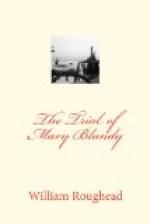in the Dictionary of National Biography, observes,
“Apart from her [Mary Blandy’s] statement
there was nothing to connect him with the murder.”
These writers seem to have overlooked the following
important facts:—The letter written by Cranstoun
to Mary, read by Bathurst in his opening speech, the
terms of which plainly prove the writer’s complicity;
and the packet rescued from the fire, bearing in his
autograph the words, “The powder to clean the
pebbles with,” which, when we remember the nature
of its contents, leaves small doubt of the sender’s
guilt. “A supposition,” says Mr. Bleackley,
“that does not explain [these] two damning circumstances
must be baseless.” The nocturnal manifestations
experienced by Cranstoun, and interpreted by his friend
Mrs. Morgan as presaging Mr. Blandy’s death,
must also be explained. Further, it would be interesting
to know how the defenders of Cranstoun account for
the warning given him by Mary in the intercepted letter—“Lest
any accident should happen to your letters, take
care what you write.” That this was
part of a subtle scheme to inculpate her lover will,
in the circumstances, hardly be maintained. As
Mr. Andrew Lang once remarked of a hypothesis equally
untenable, “That cock won’t fight.”
Would Cranstoun have fled as he did from justice, and
gone into voluntary exile for life, when, if innocent,
he had only to produce Mary’s letters to him
in proof of the blameless character of their correspondence?
and why, when on his death those letters passed into
Lord Cranstoun’s custody, did not that nobleman
publish them in vindication of his brother’s
honour, as he was directly challenged to do by a pamphleteer
of the day? The Crown authorities, at any rate,
as we have seen, did not share the opinion expressed
by the writers above cited; and from what was said
by Mr. Justice Buller, in the case of George Barrington
(Mich. 30 Geo. III., reported Term Rep. 499), it appears
that Cranstoun, for his concern in the murder of Mr.
Blandy, was prosecuted to outlawry, the learned judge
observing with reference to the form adopted on that
occasion, “It was natural to suppose groat care
had been taken in settling it, because some of the
most eminent gentlemen in the profession were employed
in it.”
“Alas! the record of her page will
tell
That one thus madden’d, lov’d,
and guilty fell.
Who hath not heard of Blandy’s fatal
fame,
Deplor’d her fate, and sorrow’d
o’er her shame?”
Thus the author of Henley: A Poem (Hickman & Stapledon, 1827); and, indeed, the frequent references to the case in the “literary remains” of the eighteenth and nineteenth centuries bear witness to the justice of that poetic observation.




